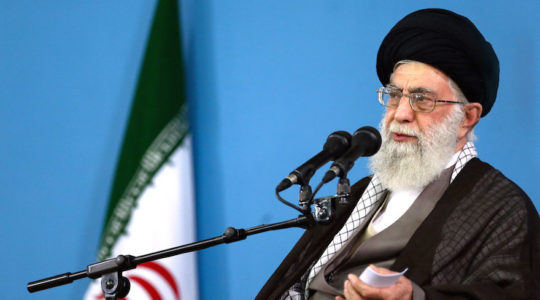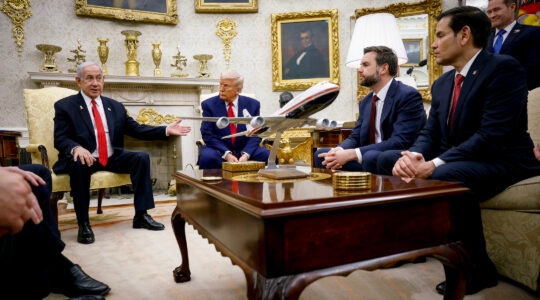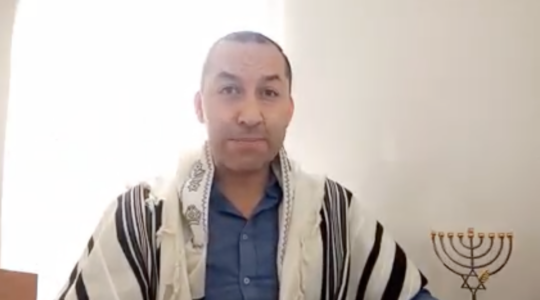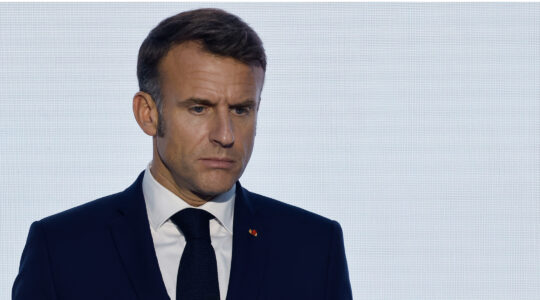
Rabbi Joshua Spinner, left, the head of the Ronald S. Lauder Foundation’s Germany operation, makes the final preparations for the Segal-Chernyak wedding, Oct. 25, 2009. The ceremony was the first marriage of an Orthodox couple in Leipzig in decades. (Ben Harris)

Pasha Segal and Anya Chernyak on their wedding day in Leipzig on Oct. 25, 2009. The pair are one of only a handful of young observant couples in the city. (Ben Harris)
LEIPZIG, Germany (JTA) — At age 12, Pasha Segal arrived in Braunschweig, Germany from Ukraine knowing he was Jewish but lacking any further understanding of what that meant.
At 19, he underwent ritual circumcision at a facility in Belgium designed for Jews like him.
And last week, at 23 and still rosy-cheeked, Segal married Anya Chernyak, 22, in a ceremony that is believed to be the first wedding of an Orthodox Jewish couple in Leipzig since World War II.
The newlyweds are one of only a handful of observant couples in the city, but both they and the rabbis involved in building the Leipzig community are confident their marriage will be an inspiration for others.
“It shows that Jewish life goes on, that you can be religious and Jewish here in Leipzig,” said Rabbi Dovid Chandalov, the director of the Leipzig ToraZentrum, where the couple met.
Chandalov predicted that the wedding would spur other Russian-speaking immigrants in the city to seek out Jewish nuptials.
Across Germany, the arrival of some 90,000 Jewish immigrants from the former Soviet Union in the 20 years since the fall of the Iron Curtain has brought both challenges and opportunities for Jewish life here.
Leipzig has become not only a growing community — like scores of others, its Jewish population exploded from nearly nothing in 1989 to well over 1,000 today — but an Orthodox Jewish hub, funneling students from around the region to institutions of Jewish learning in Berlin and beyond. In this eastern German city of more than 500,000, it has had the effect of exporting Leipzig’s most active Jews to other communities throughout the country.
Just this year, the ToraZentrum sent two boys to Berlin’s Yeshivat Beit Zion, about a fifth of whose students hail from Leipzig, and three girls to its sister school for women, the Midrasha, according to Chandalov. All three institutions are supported by the Ronald S. Lauder Foundation.
The number of young Leipzig Jews interested in Judaism, as a proportion of the total Jewish population, “is off the charts compared to anywhere else in the country,” said Rabbi Joshua Spinner, the foundation’s vice president and director of its Germany operation, known as Lauder Yeshurun.
Spinner said the German authorities erred in spreading Russian Jews across the country when they began arriving in droves after the fall of communism. As a result, many communities are too small to support viable Jewish life.
“We can’t put kindergartens, schools and yeshivas in every community in this country,” Spinner said. “The only viable outreach model for those dispersed populations of Jews in Germany is to think regionally.”
A similar effort to turn Hamburg into a major Jewish center was attempted but foundered. Spinner’s best explanation for Leipzig’s success is the one offered by his Chasidic friends, who believe it stems from the merit of Rabbi Sholom Yosef, the scion of a Chasidic dynasty who died here while passing through town and whose grave remains a pilgrimage site.
Leipzig’s ToraZentrum draws participants from as far as a two-hour train ride away. Its target population is more or less exclusively Russian-speaking immigrants who typically lack even the most rudimentary Jewish education. Some didn’t learn of their religious roots until they were old enough to ask.
Between 30 and 40 students now participate in the center’s Tuesday Jewish studies program, earning a monthly stipend of about $100 that both students and administrators admit amounts to a thinly veiled bribe.
“It’s local, it’s homegrown, it’s grass roots,” Spinner said. “It’s all the things we in these Jewish organizations always claim to believe in and very unconvincingly actually step back and allow to take place.”
Chaim Karpushkin, 20, a native of Latvia, studied at the ToraZentrum for two years because of the money offered. The product of a secular family, Karpushkin was skeptical about becoming religious until a rabbi from Berlin came to Leipzig and took him to a performance by the New York rock band Gogol Bordello, which plays East European-style “Gypsy music.”
The experience demonstrated to him that one could be both observant and appreciative of modern music, Karpushkin said. Now he has taken off a half a year to study at Beit Zion in Berlin before commencing university studies.
Stories like Karpushkin’s abound in Leipzig, where seemingly every young attendee at the Segal-Chernyak wedding was an immigrant from the former Soviet Union.
Lacking much of a Jewish identity as children, they now appear well on the road to religious observance, arriving in Leipzig for the wedding from Jewish communities elsewhere in Germany.
Segal, the groom, himself was a reluctant student of Torah, but he attended classes in Braunschweig at his parents’ urging. As he grew more religious, his parents began to have misgivings. Now both he and Anya work for the Leipzig center — he as technical director of its various camp programs, she as co-director and program director.
Clad in a white kittel and black hat for the wedding ceremony, only Segal’s occasionally halting Hebrew gave away the recency of his embrace of Orthodoxy. As the couple descended from the bimah after the ceremony, they were swarmed by a sea of bobbing black hats and yarmulkes singing and dancing as they inched their way down the synagogue’s narrow aisles and out into the street. Passers-by on bicycles slowed to take in the scene.
“I think it’s very important for Leipzig also,” Segal said of the significance of an Orthodox couple marrying in the city. “The community tried to get more religious, but they don’t know what is a Jewish wedding.”
JTA has documented Jewish history in real-time for over a century. Keep our journalism strong by joining us in supporting independent, award-winning reporting.





